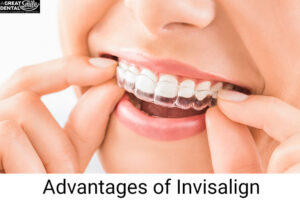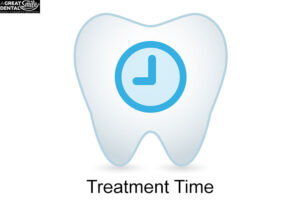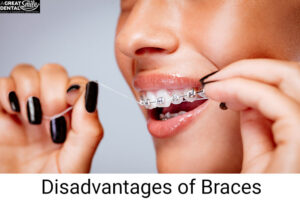Choosing between braces and Invisalign for teeth straightening is a significant decision that many of our patients face. As a dentist office in Las Vegas, NV we emphasize the importance of conducting thorough research and engaging in discussions to arrive at a well-informed choice. The optimal orthodontic solution varies among individuals, heavily depending on the specific issues at hand. In some cases, Invisalign might not be the most effective option.
Through this discussion, we aim to unfold the advantages and drawbacks of both Invisalign and traditional braces, providing clarity to aid in your decision-making process. Traditional braces, which may be made from metal and affixed to the front of the teeth, have evolved to include ceramic and lingual (behind the teeth) options. These braces use metal wires and elastic bands attached to brackets to adjust and align your teeth properly.
On the other hand, Invisalign involves employing clear, plastic aligners tailored specifically for each patient through a 3D scan of their mouth. These custom aligners gradually shift the teeth into their desired position.
As your dentist, we’re here to guide you through evaluating the suitability of each option for your unique dental structure and lifestyle, ensuring you embark on the journey towards achieving the smile you’ve always desired.
Choosing between Invisalign and traditional braces involves considering various factors to determine which option best suits your needs. Here, we’ll discuss the benefits and potential drawbacks of Invisalign to help inform your decision.
Benefits of Invisalign
 Aesthetic Appeal: One of the most significant advantages of Invisalign is its nearly invisible appearance. Adults and teenagers alike appreciate the discretion Invisalign offers, allowing orthodontic treatment without the noticeable presence of metal braces. This feature means less self-consciousness in social situations and photographs.
Aesthetic Appeal: One of the most significant advantages of Invisalign is its nearly invisible appearance. Adults and teenagers alike appreciate the discretion Invisalign offers, allowing orthodontic treatment without the noticeable presence of metal braces. This feature means less self-consciousness in social situations and photographs.
Dietary Flexibility: Invisalign aligners are removable, allowing you to eat and drink without the dietary restrictions often associated with traditional braces. This convenience lets you maintain your current eating habits without worry.
Ease of Oral Hygiene: Since you can remove the aligners, continuing your regular brushing and flossing routine is straightforward, helping to maintain oral health throughout your treatment.
Reduced Orthodontic Visits: Invisalign often requires fewer visits to the orthodontist or dentist office compared to traditional braces, as the treatment plan and aligners are prepared in advance. This aspect can be particularly appealing for those with busy schedules.
Comfort: Invisalign aligners are custom-made from smooth plastic and fit snugly over your teeth, reducing the likelihood of irritation inside your mouth, a common issue with metal braces.
Invisalign Disadvantages
Discipline Required: The success of Invisalign treatment depends on wearing the aligners for 20-22 hours daily. Failure to adhere to this can extend treatment time or compromise results.
Management of Aligners: Removing aligners before each meal or drink (other than water) can be cumbersome, especially in public. Proper oral hygiene must be maintained to prevent staining of the aligners and tooth decay.
Cost Factors: Invisalign and braces can be comparably priced, but specific cases may require transitioning to braces for optimal results, potentially increasing overall costs.
Treatment Limitations: Invisalign may not be suitable for more complex orthodontic cases, necessitating a thorough consultation with an orthodontist to determine the best treatment method.
Effectiveness Compared to Braces: While Invisalign offers an aesthetically pleasing alternative to traditional braces, it’s not ideal for everyone. Some patients may require attachments to assist with the movement of teeth, making the aligners appear more like clear braces.
Before deciding, consult with a knowledgeable and experienced orthodontist who can provide personalized advice based on your specific situation. The right choice depends on various factors, including the complexity of your orthodontic needs, lifestyle preferences, and desired outcomes.
Need for Attachments: To enhance the effectiveness of Invisalign, some patients may require attachments or button-like anchors that help the aligners grip the teeth better. While these attachments are designed to be discreet, they can make the aligners more noticeable, somewhat diminishing the aesthetic advantage of Invisalign over traditional braces.
Making an informed decision between Invisalign and braces involves understanding these factors and discussing your specific needs and lifestyle with a knowledgeable orthodontist. This guidance will help determine the most suitable treatment path for achieving a healthy and beautiful smile.
Pros of Braces
Exploring the benefits of braces, both traditional and the newer lingual options, reveals why they continue to be a popular choice for orthodontic treatment. Here are some advantages braces offer:
Versatility in Treatment: Braces are capable of correcting a wide range of dental and facial irregularities, no matter the complexity. Their use of anchors and an arch wire efficiently moves teeth to their correct positions, making them a highly effective method for achieving an ideal smile.
Optimal Results: When it comes to moving teeth into the exact desired position, braces often outperform Invisalign. The continuous force applied by braces can lead to more precise outcomes in teeth alignment.
 Variety of Options: Today’s orthodontic patients have more choices than ever before. Beyond traditional metal braces, there are lingual (behind the teeth) and ceramic braces, offering less visibility during treatment and providing an aesthetic alternative for those concerned about the appearance of metal braces.
Variety of Options: Today’s orthodontic patients have more choices than ever before. Beyond traditional metal braces, there are lingual (behind the teeth) and ceramic braces, offering less visibility during treatment and providing an aesthetic alternative for those concerned about the appearance of metal braces.
Efficiency in Treatment Time: When comparing the speed of treatment between braces and Invisalign, braces frequently offer a quicker path to achieving your orthodontic goals. This efficiency is especially appealing to those eager to complete their orthodontic journey as swiftly as possible. Additionally, the expertise of a specialist orthodontist can further enhance the speed and effectiveness of treatment.
Disadvantages of Metal Braces
 While braces are a proven method for achieving straighter teeth, there are several considerations to keep in mind:
While braces are a proven method for achieving straighter teeth, there are several considerations to keep in mind:
Aesthetic Concerns: The visibility of traditional braces can cause some individuals to feel self-conscious, especially in social situations where they might be concerned about their appearance.
Oral Hygiene Challenges: Maintaining oral hygiene becomes more complicated with braces. Inadequate cleaning can lead to plaque accumulation around the brackets, resulting in potential staining and tooth decay. It’s crucial to adhere to your orthodontist’s guidance on proper brushing and flossing techniques.

Dietary Restrictions: Wearing braces requires being mindful of your diet. Consuming hard or sticky foods can damage the braces, necessitating repairs before treatment can proceed. Such incidents not only cause inconvenience but can also extend the duration of the treatment.
Frequent Orthodontic Appointments: Treatment with braces involves regular orthodontic visits, typically monthly, to monitor progress and adjust the braces as needed. These check-ups are essential for ensuring your teeth move according to the treatment plan.
It’s important to weigh these factors against the potential benefits of braces. Despite the drawbacks, braces offer a reliable solution for a wide range of orthodontic issues. Regular consultations, although more frequent than with Invisalign, play a critical role in achieving the desired outcomes.
Selecting the ideal orthodontic treatment involves thoughtful deliberation over several key considerations, such as evaluating the benefits and drawbacks that align most closely with your personal lifestyle and dental objectives. Engaging in meaningful conversations and asking pertinent questions to your orthodontist are essential steps towards amassing the detailed information needed to ensure your decision is well-informed and meets your expectations and requirements. For adults considering orthodontic work, advancements in modern braces technology offer a viable path to achieving the smile you’ve always envisioned, making a perfectly aligned smile more attainable and efficient than ever before. If you’re prepared to enhance your smile, arranging a consultation could be the first step towards exploring a range of cutting-edge treatments, with the primary aim of securing a healthy and aesthetically pleasing smile, whether through Invisalign or traditional braces.

